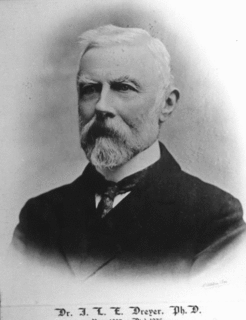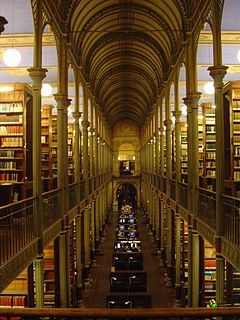
Ole Christensen Rømer was a Danish astronomer who in 1676 made the first quantitative measurements of the speed of light.

Astronomy is a natural science that studies celestial objects and phenomena. It applies mathematics, physics, and chemistry in an effort to explain the origin of those objects and phenomena and their evolution. Objects of interest include planets, moons, stars, nebulae, galaxies, and comets; the phenomena also includes supernova explosions, gamma ray bursts, quasars, blazars, pulsars, and cosmic microwave background radiation. More generally, all phenomena that originate outside Earth's atmosphere are within the purview of astronomy. A related but distinct subject is physical cosmology, which is the study of the Universe as a whole.
The year 1642 in science and technology involved some significant events.

John Louis Emil Dreyer was a Danish-Irish astronomer.

The Rundetaarn or Rundetårn is a 17th-century tower located in central Copenhagen, Denmark, and one of the many architectural projects of Christian IV of Denmark, built as an astronomical observatory. It is most noted for its equestrian staircase, a 7.5-turn helical corridor leading to the top, and for the expansive views which it affords over Copenhagen.
The Goethe Link Observatory, observatory code 760, is an astronomical observatory near Brooklyn, Indiana, United States. It is owned by Indiana University and operated by the Indiana Astronomical Society, which efforts are dedicated to the pursuit of amateur astronomy.

Brorfelde Observatory is an astronomical observatory located near Holbæk, Denmark. It is home to the Brorfelde Schmidt Telescope and was run as a branch of the Copenhagen University Observatory until 1996. It still has telescopes that are used by University of Copenhagen students, but the staff that manned them moved to the Rockefeller Complex in Copenhagen..

The Copenhagen Fire of 1728 was the largest fire in the history of Copenhagen, Denmark. It began on the evening of 20 October 1728 and continued to burn until the morning of 23 October. It destroyed approximately 28% of the city, left 20% of the population homeless, and the reconstruction lasted until 1737. No less than 47% of the section of the city, which dates back to the Middle Ages, was completely lost, and along with the Copenhagen Fire of 1795, it is the main reason that few traces of medieval Copenhagen can be found in the modern city.

Peder [Nielsen] Horrebow (Horrebov) was a Danish astronomer. Born in Løgstør, Jutland to a poor family of fishermen, Horrebow entered the University of Copenhagen in 1703. He worked his way through grammar school and university by virtue of his technical knowledge: he repaired mechanical and musical instruments and cut seals. He received his MA from the university in 1716, and his MD in 1725. From 1703 to 1707, he served as an assistant to Ole Rømer and lived in Rømer's home. He worked as a household tutor from 1707 to 1711 to a Danish baron, and entered the governmental bureaucracy as an excise writer in 1711.

Østervold Observatory is a former astronomical observatory in Copenhagen, Denmark owned and operated by the University of Copenhagen. It opened in 1861 as a replacement for the University's old observatory at Rundetårn.

Hafnia Hodierna, Eller Udførlig Beskrivelse om den Kongelige Residentz- og Hoved-Stad Kiøbenhavn is an engraved architectural work on Copenhagen, published by the Danish architect Lauritz de Thurah in 1748. Profusely illustrated throughout, it is a valuable source of knowledge as to the appearance of Copenhagen in the middle of the 18th century. It complements, with some overlap, de Thurah's other major work Den Danske Vitruvius, which focuses primarily on surrounding areas, as well as the rest of Denmark.

The Copenhagen University Library in Copenhagen, Denmark, is the main research library of the University of Copenhagen. Founded in 1482, it is the oldest library in Denmark.

Hans Christian Hansen was a Historicist Danish architect who worked 18 years in Greece where he was active in the transformation of Athens from a small town to the country's capital and an international metropolis. Later in his career he returned to Denmark where he became a professor at the Royal Danish Academy of Fine Arts and designed buildings such as the Copenhagen Municipal Hospital and the Østervold Observatory. He was the brother of Theophilus Hansen who was also an internationally successful architect, active in Athens and Vienna. He is considered to be a pioneer in the study and application of polychrome architecture.

Heinrich Gustav Ferdinand Holm, often referred to as H.G.F. Holm, was a Danish artist and engraver who is remembered for his finely detailed topographical paintings and drawings of Copenhagen and surroundings.

Moritz Georg Moshack was a builder of Danish clavichords. Three of his instruments are known to exist: a fret-free clavichord dating to 1768 at the Norsk Folkemuseum, Oslo, Norway; a single manual harpsichord dating to 1770 at the Falsters Minder Museum, Nykøbing, Falster, Denmark; and the fret-free Clavichord dating to 1770 at the Musikhistorisk Museum in Copenhagen, Denmark.
Leonhard Blasius was a Danish architect in the service of King Christian IV.

NGC 4030 is a grand design spiral galaxy located about 64 million light years away in the constellation Virgo. With an apparent visual magnitude of 10.6, it is visible with a small telescope as a 3 arc minute wide feature about 4.75° to the southeast of the star Beta Virginis. It is inclined by an angle of 47.1° to the line of sight from the Earth and is receding at a velocity of 1,465 km/s.

















